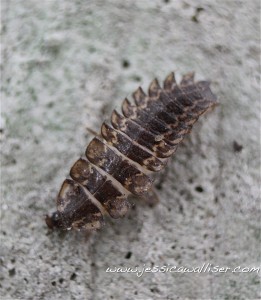 Fireflies are found on every continent except Antarctica, and there are about 150 different species of fireflies in North America. They are members of the Lampyridae family, and I found this beautiful larva on a driveway near a wetland in eastern Pennsylvania.
Fireflies are found on every continent except Antarctica, and there are about 150 different species of fireflies in North America. They are members of the Lampyridae family, and I found this beautiful larva on a driveway near a wetland in eastern Pennsylvania.
Fireflies, also commonly called lightning bugs, use their bioluminescent abdomens to attract mates. The pattern of flashes is unique to each species, as is the color of their glow. Males fly around flashing a particular pattern in hopes of finding a female of the same species. He signals first then she signals her response, often from a low perch. Flash pattern charts can be used to distinguish many common species based on the number and duration of their flashes.
In the eastern U.S., fireflies are a common summer sight, and while not all species glow as adults, they all do as larvae. Sometimes called glowworms in other parts of the world, larval fireflies, like this one, emit a steady, dull glow from their abdomens. Adult fireflies eat mostly pollen and nectar, though some species eat nothing at all.
Female fireflies lay eggs in the ground (though a few tropical species lay eggs in trees). Favored egg laying sites include moist places near ponds and streams and in leaf litter. Larval fireflies live under or on the ground and serve as generalist predators, savoring slugs, snails, worms and other insect larvae. They capture their prey and inject it with a paralytic substance before consuming it. Though not all adult firefly species glow, all firefly larvae do, and the intensity and frequency of the light increases when they are disturbed, likely as a form of protection and a warning signal to would-be predators. Both adult and larval fireflies are extremely distasteful, with some species “weeping” foul-tasting blood from their bodies when threatened. Fireflies overwinter in the soil as larvae. Come spring, the larvae begin to feed and eventually (sometimes several years later) pupate and emerge as adults in summer.







